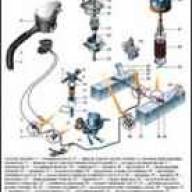Cars with ZMZ-4025 and ZMZ-4026 engines are usually equipped with a lever-type clutch with peripheral springs or a reinforced clutch with a diaphragm spring
For cars with ZMZ-406 and ZMZ-405 engines, only a clutch with a diaphragm spring is installed.
The clutch release drive is the same for both types of clutches.
Only the working cylinder is located on the ZMZ-402 engines on the left side of the clutch housing, and on the ZMZ-405, ZMZ-406 on the right side.
- Cause of malfunction Remedy
Incomplete disengagement of the clutch - the clutch “drives”
(gears do not turn on or turn on with difficulty):
- When the engine is idling, the direct transmission is engaged and the clutch is disengaged, the secondary shaft of the gearbox should not rotate
To carry out the inspection, it is necessary to remove the cardan transmission and insert a separate sliding fork of the cardan transmission into the rear gearbox housing to prevent oil leakage
- The presence of air in the hydraulic clutch drive, article - “How to pump and replace the clutch hydraulic drive fluid”
Bleed the hydraulic system of the clutch drive, make sure that the movement of the fork end is at least 14 mm
- Jamming of the driven disk hub on the splines of the input shaft
Eliminate jamming on the splines (clean the splines)
- Warping of the driven disk
Replace the driven disc or straighten it, article - “How to remove clutch discs”
- Non-simultaneous pressing of the clutch release bearing onto the clutch release levers
Adjust the relative position of the ends of the clutch release levers
Incomplete engagement of the clutch - the clutch slips
(a specific smell is felt, the car’s acceleration deteriorates, the speed of movement drops, it’s difficult to climb an incline):
- Loosening the pressure springs
Replace the springs with new ones
- Oiling the friction linings of the driven disk
Replace the driven disk or friction linings.
In case of slight oiling, wash the surface of the linings with kerosene and clean with fine sandpaper
- Excessive wear of friction linings (up to rivets), working surfaces of the flywheel and pressure plate
Replace friction linings or driven disk
Replace the flywheel or pressure plate or eliminate burrs and ring marks on them by machining, taking into account the recommendations
- The compensation hole of the master cylinder is clogged or blocked by the edge of the cuff due to swelling of the cuff
Rinse the main cylinder with working fluid or replace the cuff
Clutch engagement is not smooth:
- Oiling the friction linings of the driven disk
Replace friction linings
- Wear of friction linings (to rivets)
Replace the driven disk or friction linings
- Jamming of the driven disk hub on the splines of the input shaft of the gearbox
Eliminate jamming on splines
- Non-simultaneous pressing of the clutch release bearing on the levers
Adjust the relative position of the levers
- Loss of elasticity of the plate springs of the driven disk
Replace the driven disk
- Sticking of the clutch release levers in the supports or pressure plate protrusions in the casing windows
Eliminate jamming (clean mating surfaces)
Vibrations and noises in the transmission when driving:
- Breakage or wear of parts of the driven disk damper device
Replace the driven disk assembly
- Wear of the friction washer or weakening of the friction damper pressure spring
Replace the friction washer or damper spring
“Squeaking” and noise in the clutch when the engine is running:
- Failure of the clutch release bearing
Replace the bearing. Check and restore the alignment of the clutch housing and crankshaft
Creak when pressing the clutch pedal with the engine not running:
- There is no lubrication or the plastic bushings of the clutch pedal axle are worn
Lubricate the plastic bushings with colloidal graphite preparation (OST 08-420-74) or replace worn bushings with new ones
The clutch disengages only when the pedal is pressed sharply.
When pressed smoothly, the pedal easily reaches the stop, the clutch does not disengage:
- Contamination or excessive wear of the master cylinder mirror. Excessive wear of the master cylinder piston cuff
Rinse and if worn, replace the main cylinder. Replace the cuff, article - "Replacing the clutch master and slave cylinders"
Decreasing the fluid level in the clutch master cylinder reservoir:
- Wear or hardening of the working cylinder piston cuff - fluid leakage
Replace the cuff
- Violation of the tightness of the connection of the pipeline with the main and working cylinders - fluid leakage
Tighten the connecting nuts







